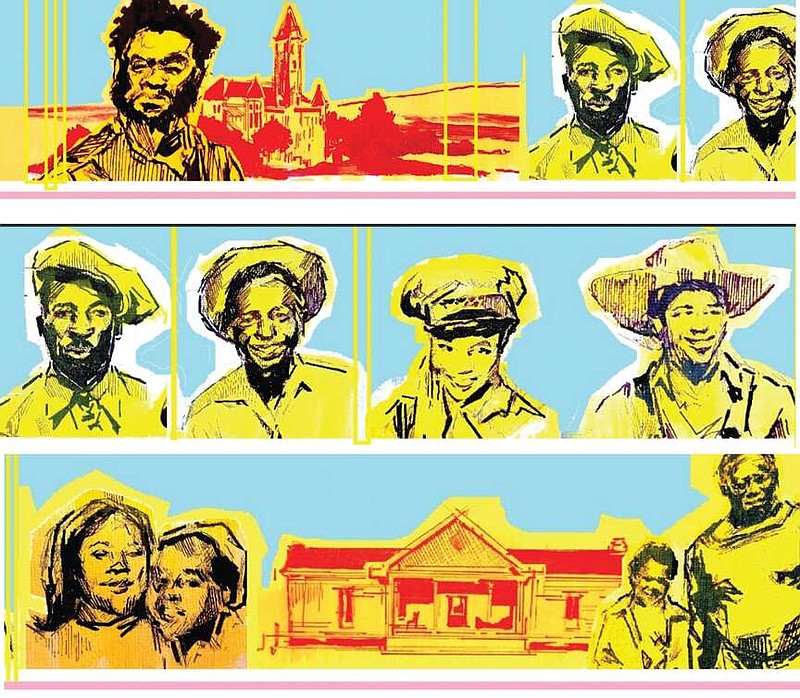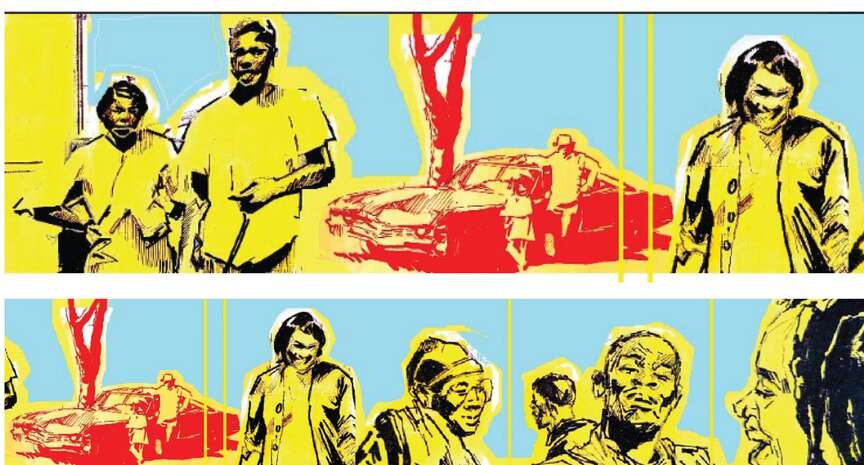FAYETTEVILLE -- A mural planned along the retaining wall on Nelson Hackett Boulevard depicts the history of the area while communicating joy to the viewer, the city's Arts Council members agreed.
The council Wednesday unanimously selected a piece from local artist Joelle Storet to adorn a 90-linear-foot section of the wall on the west side of the street. The piece is planned as one of several that will eventually cover the entire 500-foot-long wall by 2028, in time for the city's bicentennial.
The piece depicts an interpretation of what Nelson Hackett may have looked like, along with portraits of past Fayetteville residents and historical landmarks. Storet included the Washington County Courthouse as it originally appeared with no surrounding buildings and Archibald Yell's homestead that once stood where Walker Park is now.
There are no known pictures of Hackett, so Storet had to interpret what he may have looked like. Storet said she was inspired by modern plays set in the 1840s to come up with his clothing, hair and facial hair. Hackett is depicted as facing north from the courthouse, insinuating his eventual journey to Canada.
"This was clearly a man who had a plan," Storet said. "It was important to show his figure as very stoic and very much real, just like the other characters who are depicted throughout the rest of the wall."
Hackett was the first and last enslaved person to be extradited from Canada back to the United States. His journey set off an international discourse on extradition policy.
Hackett fled Fayetteville in 1841 seeking freedom, making his way to Canada, according to research from Michael Pierce, associate history professor at the University of Arkansas, Fayetteville. The man who claimed to own Hackett demanded extradition.
Yell, Arkansas' governor at the time, wrote a letter to the colonial governor of Canada requesting Hackett be returned. The request was granted.
Hackett was brought back to Fayetteville in the summer of 1842. He was publicly whipped several times, tortured and sold back into slavery in Texas, according to Pierce's research. He escaped again, and his fate remains unknown.
Abolitionists worried slave owners could use accusations of theft or other offenses to extradite enslaved people. The British government subsequently made laws preventing such extradition, according to Pierce's research.
The city renamed the street from Archibald Yell Boulevard to Nelson Hackett Boulevard in 2022.
The other faces in the piece are those of a family with longtime ties to the city, Storet said.
The figures move along the wall in chronological order, ending with the face of a child looking back to the people who came before her. Storet said she wanted to depict the concept that education allows families to grow.
Storet said she hopes onlookers will enjoy the piece's visual aesthetics and ask questions about the city's history.
"I wanted to engage people," she said. "I want people to be like, 'Wow, this is a part of our history,' and maybe it will encourage more artists to do historical murals. It's free education."
Storet worked with Fayetteville resident Jessica Gray to get pictures of Gray's family to use as inspiration for the mural. Gray's grandmother, Dorothy Barker-Wilks, died in 2022 at the age of 102 and had originally moved to the city from Summers, a small community west of Lincoln. Subsequent generations of the family grew up in Fayetteville.
Several members of Gray's family are displayed in the piece. Her mother, Teresa Gray, and Teresa Gray's father, Lafayette Barker, are depicted standing in front of a car at their downtown home. Barker-Wilks can be seen right of the car. Teresa Gray's brother and sister, Bobby Barker and Patricia Pendergraft, are shown left of the car. Several other relatives also are included.
Knowing her family will be depicted on a mural along a prominent wall that sees lots of car and pedestrian traffic elicits a bittersweet feeling for Jessica Gray, she said. Gray said she wishes her grandmother could have seen it.
"I'm honored that Joelle would even take an interest in my family," Gray said. "I think it's nice to see something reflective of the history of that area."
The city received 81 submissions from artists all over the country seeking to do the mural, said Joanna Sheehan Bell, the city's arts and culture director. The Arts Council narrowed the submissions to five and asked those five applicants to come up with mockups for the piece, she said.
A subcommittee consisting of members from the city's Arts Council, Historic District Commission and Black Heritage Preservation Commission reviewed the five mockups Tuesday. The subcommittee unanimously selected Storet's piece and forwarded it to the full Arts Council for approval.
Arts Council members Wednesday approved the selection. Members praised Storet's mindful depiction of history while also conveying a sense of joy. The only note members made was to have some kind of transition between Storet's piece and the existing piece by Springdale artist Jeremy Navarrette on the wall's southernmost side.
"She understood the assignment and she nailed it," said Bob Stafford, an Arts Council member who also represents the south part of town on the City Council.
The city asked artists to create a mural that embodies the themes of movement, justice and connectivity. The goal was to enhance the area's visual landscape and foster community engagement.
The project includes a commission of $24,000 to cover artist fees and materials, with a completion deadline set for June 15. Bell said the money is coming from the city's capital project budget.
The city plans to unveil the finished piece to the public on the Juneteenth holiday, June 19.
"I think it's a really beautiful expression of Fayetteville's past, present and future," Bell said. "There's a lot of joy in the mural, as well as reflection. I think that was a really nice balance to strike."
Nelson Hackett Boulevard mural project
The murals will be on a concrete retaining wall that extends from the intersection of East Rock Street to South Block Avenue. The wall faces predominantly south, with the ends facing slightly east and west, respectively. The section of Nelson Hackett Boulevard primarily receives automobile traffic with some pedestrian traffic. The intent is to fill the wall with murals over time. The theme for the pieces is "Experience the Adventure of Fayetteville." The wall has a troweled texture, is approximately 7½ feet high and extends approximately 500 linear feet.
Source: Fayetteville



